[Note lại]
On 17 September the Court of Justice of the European Union (CJEU) handed down a long-awaited judgment on a matter that thrilled sports fans and the IP community. Footballer Lionel Messi Cuccittini is allowed to register his surname as a trademark for a sportswear brand after a nine-year legal battle. The trade mark is a figurative sign in particular for clothing, footwear and gymnastics and sports articles:
A Spanish cycling company, which started its business under the name MASSI before “Messi” was launched onto the market, opposed the application for identical goods. While the European Union Intellectual Property Office (EUIPO) considered that there was a likelihood of confusion, the General Court thought otherwise. Both the EUIPO and the opponent appealed to the CJEU but failed. The CJEU confirmed that there was no likelihood of confusion.
The key rationale was that the football player’s fame neutralized the visual and phonetic similarities between two signs. The CJEU pointed out that, like the reputation of the earlier trade mark (para. 46), the reputation of the person applying for registration of his name as a trade mark was one of the relevant factors for the assessment of likelihood of confusion, as the reputation of the person applying for registration of his surname may influence the perception of the trade mark by the relevant public.
Ngày 17 tháng 9, Tòa án Công lý của liên minh Châu Âu (CJEU) đã đưa ra phán quyết về vấn đề cầu thủ bóng đá Lionel Messi được phép đăng ký họ của mình làm nhãn hiệu cho lĩnh vực đồ thể thao (gồm quần áo, giày dép, các mặt hàng thể dục thể thao khác) sau cuộc chiến pháp lý kéo dài 9 năm.
Lý do là có một công ty xe đạp của Tây Ban Nha - cũng được coi là lĩnh vực đồ thể thao - đã kinh doanh với nhãn hiệu Massi trước khi nhãn “Messi” có mặt trên thị trường. Khi nhãn Messi tung ra thị trường, công ty này đã gửi đơn phản đối rằng nhãn hiệu Messi giống Massi của họ. Văn phòng Sở hữu Trí tuệ của Liên minh Châu Âu (EUIPO) cũng đồng ý rằng có khả năng xảy ra nhầm lẫn, tuy nhiên Tòa án Chung lại nghĩ khác. Cả EUIPO và công ty xe đạp của TBN đều kháng cáo CJEU nhưng không thành công. CJEU xác nhận rằng không có khả năng xảy ra nhầm lẫn.
Cơ sở lý luận của CJEU là sự nổi tiếng của cầu thủ bóng đá khiến cho không còn sự tương đồng về hình ảnh và ngữ âm giữa hai dấu hiệu Massi và Messi. CJEU cho rằng, sự nổi tiếng của Messi đủ để ảnh hưởng đến nhận thức của công chúng về nhãn hiệu thương mại và không gây nhầm lẫn.
On 17 September the CJEU handed down a long-awaited judgment on a matter that thrilled sports fans and the IP community (C-449/18P, C-474/18P, available in French and Spanish). Footballer Lionel Messi Cuccittini is allowed to register his surname as a trademark for a sportswear brand after a...

trademarkblog.kluweriplaw.com
Art 16.1 Trips: The owner of a registered trademark shall have the exclusive right to prevent all third parties not having the owner’s consent from using in the course of trade identical or similar signs for goods or services which are identical or similar to those in respect of which the trademark is registered where such use would result in a likelihood of confusion. In case of the use of an identical sign for identical goods or services, a likelihood of confusion shall be presumed /Chủ sở hữu nhãn hiệu đã đăng ký có quyền ngăn chặn tất cả các bên thứ ba sử dụng các nhãn giống hệt hoặc các nhãn tương tự đối với hàng hoá hoặc dịch vụ giống hoặc tương tự với hàng hoá hoặc dịch vụ mà nhãn hiệu đã đăng ký mà không được sự đồng ý của chủ sở hữu vì như vậy sẽ dẫn đến khả năng nhầm lẫn (sử dụng trong các hoạt động kinh doanh thôi ạ). Trong trường hợp sử dụng một dấu hiệu giống hệt nhau cho hàng hóa hoặc dịch vụ giống hệt nhau, sẽ có khả năng gây nhầm lẫn (và như vậy là không được phép). Ở đây có mấy thứ tượng tự:
+ Nhãn Massi đã được đăng ký ở TBN, nằm trong khối các nước EU
+ Ngành kinh doanh của Massi là xe đạp (xe đạp thể thao), Messi cũng đăng ký các nhóm ngành liên quan đến thể thao và các mặt hàng thể thao khác)
+ Massi với Messi gần tương tự nhau về hình ảnh nhưng vẫn có khả năng phân biệt được - Quan điểm cá nhân: với phát âm thì nó có thể tương tự ở mức gây nhầm lẫn.
Vì sao không từ chối? là vì CJEU họ thấy đủ để phân biệt (không gây nhầm lẫn).
Cơ sở lý luận của CJEU là sự nổi tiếng của cầu thủ bóng đá khiến cho không còn sự tương đồng về hình ảnh và ngữ âm giữa hai dấu hiệu Massi và Messi. CJEU cho rằng, sự nổi tiếng của Messi đủ để ảnh hưởng đến nhận thức của công chúng về nhãn hiệu thương mại và không gây nhầm lẫn. Em đang tìm cái đoạn mở ngoặc paragrap 46 mà CJEU họ dựa vào để đọc xem nó như nào.
------------------------------------------------------------------------------------------
Case tiếp theo là một bài thi của trường Luật Harvard
https://cyber.harvard.edu/people/tfisher/IP/Copyright_Exam_2014.pdf .
Cảm ơn cụ
Mentor đã giới thiệu những case này, đọc rất hay.
Part I Portions of the following narrative are loosely based on real events. However, all of the persons and most of the actions are fictional. In addition, the chronology of the real events has been altered. If you happen to know or learn something about the events upon which the narrative is founded, you should ignore that knowledge when you answer the question. [đoạn này xin phép nhờ google translate]
Skeleton is a winter sliding sport, usually performed on a bobsled course. Competitors lie face down on steel sleds and try to complete the course as quickly as possible. Speeds of over 80 miles per hour (130 kilometers per hour) are common. The sport was invented in Switzerland in the late nineteenth century but, until recently, was little known in the United States. Since 2002, when it first became a regular part of the Olympics, its popularity has grown rapidly. Skeleton racers typically wear skin-tight suits and helmets. Both are designed to reduce air resistance. Most of the men and women who compete in the sport are extroverted, even flamboyant. In recent years, they have begun emblazoning their helmets with dramatic designs. Examples appear in Figures 1 and 2
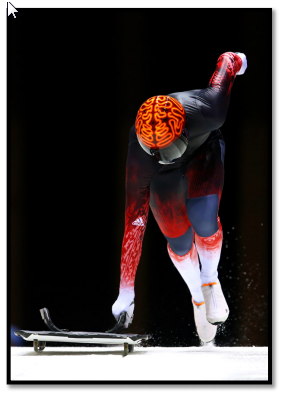
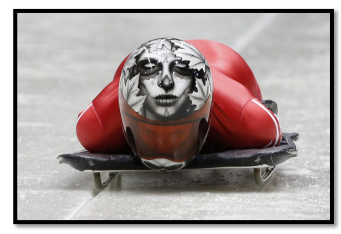
Sketeton (tiếng Việt gọi là trượt băng nằm sấp) là một môn thể thao mùa đông được biết đến đầu tiên ở Thụy Sĩ (có link tham khảo) và năm 2002 nó bắt đầu trở thành một môn thể thao chính thức trong Thế vận hội. Các tay đua sẽ mặc những bộ đò bó sát, đội mũ bảo hiểm và nằm sấp lên một tấm ván, đầu hướng về phía trước và trượt đi với tốc độ rất lớn (>130km/h). Hình 1 là khi vào đường đua, hình 2 là trên đường đua.
Link tham khảo ngoài
*Tình huống thảo luận ở phút thứ 3:18
Wendy Welker is one of the best skeleton racers in the United States, indeed in the world. She lives in Park City, Utah, and regularly practices on the nearby bobsled course (originally built for the Salt Lake City Olympics). In the summer of 2013, Wendy was selected for the United States skeleton team, which in February of 2014 would compete in the Winter Olympics in Sochi, Russia. Lance Lawrence is one of Wendy’s friends. In the spring of 2011, Lance graduated from Yale University with a GDMFA (Masters in Fine Arts, Graphic Design). He tried to obtain a job in one of the advertising agencies in New York City, but was unable to find a position. Reluctantly, he moved home to Utah. Since September of 2011, Lance has been employed by Brain Buckets, a small company located in Salt Lake City that designs and manufactures custom motorcycle helmets. As a result of his job, Lance has become adept at “airbrushing” onto helmets unique graphic designs (most often involving skulls or action figures), but he yearns for more challenging work. Lance was thus relieved when, on September 1, 2013, Wendy sent him the following email message: “Hey, I’d like to make a splash in Sochi. Could you make me a really hot skeleton helmet? I’ll send you a plain white one. Can you do something to make it dazzling? As you know, I don’t have a lot of money, but could pay you $500.” Lance wrote back: “Sure. It would be a fun project. But let’s keep this confidential, OK? I’d rather my boss not know.” Wendy responded: “Fabulous. I need it by November. I can’t thank you enough.” A few days later, Wendy sent Lance a generic white skeleton helmet that already had been fitted to her head and tested for aerodynamic efficiency.
Mùa hè năm 2013 Wendy Welker (sống tại bang Utah, Mỹ) được chọn là vận động viên tham gia thế vận hội mùa đông tại Sochi (Nga) vào tháng 2/2014.
Lance Lawrence, một người bạn của Wendy, sau khi tốt nghiệp Thạc sĩ ở Yale đã chuyển tới Utah và làm việc cho một công ty thiết kế và sản xuất mũ bảo hiểm Brain Buckets vào tháng 9/2011.
Tháng 9/2013 Wendy gửi cho Lance một email nội dung là: Hãy giúp tôi thiết kế một chiếc mũ ấn tượng, tôi muốn gây ấn tượng tại thế vận hội Sochi, tôi sẽ trả bạn 500$ cho việc này”. Lance trả lời: “Hãy giữ bí mật việc này vì tôi không muốn sếp của tôi biết”. Wendy: “Tôi cần nó trước tháng 11”. Và sau đó Wendy đã gửi cho Lance chiếc mũ mình sẽ đội trong thế vận hội (màu trắng trơn).
During September, Lance spent a few evenings at home, working on the project. He first considered a variety of abstract designs, but soon decided that the helmet would be more striking if it depicted an animal. Both the nature of skeleton racing and Wendy’s personality, he concluded, suggested that the animal should be aggressive and fearless. He sketched a design based upon a grizzly bear, but found that it did not fit well the shape of the helmet. A second design depicting a wolf likewise proved unsatisfying. One Saturday in early October, while Lance was hiking in the Wasatch Mountains, an eagle flew overhead. “Aha!,” he thought. An eagle’s head, he realized, would conform well to the shape of the helmet. And the image, he thought, could be both fierce and patriotic. (The bald eagle is the national bird of the United States.) That evening, Lance went to the Salt Lake City Public Library and browsed the section on birds, looking for photographs or drawings he might employ as reference works. None of the contemporary books proved helpful, but an older book contained just what he was looking for. “The Iconography of Raptors” (written by Mark Madison and published by Harvard University Press in 1974) reprinted myriad depictions of eagles, both realistic and stylized. Lance spent an hour flipping through the book and finally selected one drawing that he thought would be perfect. It depicted the head of a bald eagle, with a “facial” expression that seemed both focused and angry. The book explained that the drawing had originally been created in 1970 by Russell Rockefeller, who had hoped to license it to the United States Post Office as the design for a stamp. The Post Office, apparently fearing that the image would suggest endorsement of the War in Vietnam (a contentious issue at the time), had rejected it. However, the martial spirit of the drawing suited Lance just fine. He carried the book down to the basement of the library, where there was a high-quality coin-operated color copier. He used the machine to make a single copy of the page containing Russell’s image, returned the book to the shelf, and departed.
Tháng 9, Lance bắt tay vào thiết kế, ý tưởng của anh là sẽ vẽ một con vật gì đó “aggressive and fearless” (đại ý là can đảm và thiện chiến). Một ngày đầu tháng 10, đang đi trên đường thì Lance thấy 1 con đại bàng bay trên đầu, anh nghĩ ngay đến việc lấy hình tượng con chim đai bàng vì nó vừa là thể hiện được ý tưởng vừa mang tính quốc gia (bald eagle là national bird của nước Mỹ) – Ngoài lề một chút: The Bald Eagle có gặp trong một vài case khác nữa.
Lance đã đến thư viện và tìm kiếm các bức ảnh/ bản vẽ để tham khảo, cuối cùng Lance cũng đã chọn được 1 bức vẽ mà anh cho rằng nó hoàn hảo (bức vẽ này là tác phẩm của Russell Rockefeller năm 1970, đã từng xin cấp license – tiếng việt gọi là cấp li xăng, nghĩa là cấp phép – nhưng bị từ chối do thời điểm đó có vài vấn đề gây tranh cãi rằng hình ảnh này có thể gợi đến chiến tranh tại Việt Nam - đoạn này thì không quan trọng và cũng không hiểu nó có liên quan gì đến chiến tranh VN, nhưng thôi cứ viết vào.
Lance spent the following morning in his workshop at home, sketching eagle designs for Wendy’s helmet. He taped the copy of Russell’s drawing to the wall over his workbench and referred frequently to it when making his sketches. Lance tried to retain the simplicity and the overall mood of Russell’s eagle. However, in each successive draft, he deviated further from Russell’s drawing. The eagle that appeared in Lance’s final draft differed from Russell’s eagle in the following respects: the “face” was wider; the beak was larger; the “eyebrows” were darker; the feathers were more sharply defined; and the eyes were green, rather than yellow. Finally, Lance added wavy red-and-white stripes to cover the portion of the helmet not occupied by the eagle image. When Lance was satisfied, he discarded his copy of Russell’s drawing and all of his preliminary drafts. He then spent the afternoon (using his own paints, solvents, and tools) airbrushing onto the helmet a permanent version of the image. His final product is shown in Figure 3.
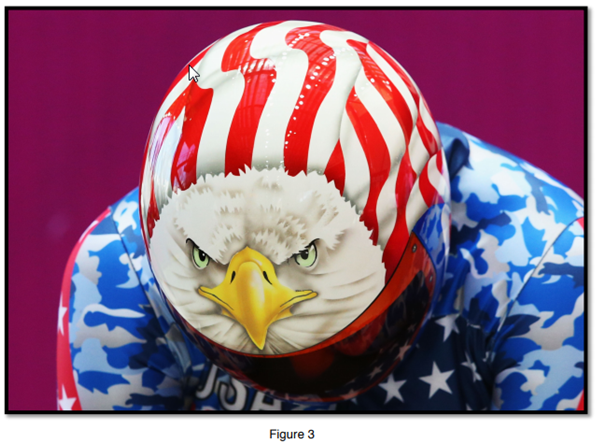
At the time, Wendy was practicing in Lake Placid, New York, so Lance mailed her the finished helmet. When Wendy opened the box, she was elated. She sent Lance a check for $500, along with a note that simply said, “Intense!” Lance wrote back: “So glad you like it! Do whatever you want with it; it’s all yours.” During all of her subsequent training runs and during the Olympics itself, Wendy wore the helmet proudly. The photographs in Figures 4 and 5 show her during two of her runs in Sochi.
Unfortunately, Wendy did not do as well in the Olympics as she had hoped. She finished fourth in the women’s event, narrowly missing out on a bronze medal. Despite this disappointing result, her races were featured in NBC’s televised coverage of the Olympics. As a result, millions of viewers of NBC’s broadcasts in the United States saw several images of the helmet.
Lance đã vẽ lên mũ, anh cố gắng giữ lại cái thần thái của Đại bàng nhưng có thay đổi một chút về hình dáng, mặt đại bàng, lông mày, mắt… và có kẻ sọc đỏ trắng như trong hình 3.
Thời điểm đó Wendy đang tập luyện tại New York và Lance đã gửi cho Wendy chiếc mũ. Nhận được mũ Wendy rất hài lòng, Wendy đã gửi cho Lance 500$ kèm thêm lời nhận xét “Intense!”
Lance viết lại “Bạn có thể làm bất cứ điều gì bạn muốn, đó là của bạn”
Hình 4 và 5 là hình ảnh tại thế vận hội mùa đông, tổ chức tại Sochi 2014
Wendy đã đứng thứ 4 và dành huy chương đồng, cuộc đua của cô được phát sóng trên NBC và hàng triệu người đã thấy chiếc mũ.
A few weeks after Wendy returned home from the Olympics, similar helmets began to appear in a variety of contexts. To be sure, eagles had been drawn on helmets for many years. For example, for decades the Philadelphia Eagles professional football team had used a helmet design featuring stylized eagle wings on the sides. (See Figure 6 on the following page.) And, on occasion, the heads of bald eagles had been placed on helmets – for example on the welding helmet shown in Figure 7 on the following page. //
Vài tuần sau khi kết thúc thế vận hội, những chiếc mũ tương tự đã bắt đầu xuất hiện. Nói thêm rằng trước đó nhiều năm thì hình ảnh chim đại bàng cũng đã từng được vẽ nhiều trên mũ bảo hiểm như cánh đại bàng (hình 6), đầu đại bàng (hình 7) nhưng khuôn mặt thì hầu như là không.
But prior to March of 2014, it had been highly unusual for the “face” of a bald eagle to appear on the “forehead” of a helmet. A rare example is the hockey mask depicted in Figure 8 – which had been created in 2001 by a father for his son, who played goalie for a high-school team in Boston. //
Tuy nhiên trước đó, vào năm 2001, cũng đã từng xuất hiện hình ảnh mặt chim đại bàng trên chiếc mũ bảo hiểm trong trò chơi khúc côn cầu, tuy nhiên đó là một hình ảnh rất hiếm hoi.
By contrast, starting in March of 2014, such helmets suddenly began to appear in many settings in the United States: in ski races (Figure 9); on professionally manufactured hockey masks (Figure 10); on bicycle helmets (Figure 11); and on baseball “catcher’s” masks (Figure 12). //
Ngược lại, sau tháng 3/2014 rất nhiều chiếc mũ vẽ mặt đại bàng xuất hiện….
As helmets of these sorts proliferated, Lance became increasingly angry. On April 25, 2014, he wrote Wendy an email with the subject line: “Everyone is stealing my eagle!!!” Wendy wrote back: “Hey, it’s my eagle as much as yours. But I agree, it’s an outrage! What should we do?” //
Điều này khiến Lance cảm thấy tức giận, anh viết cho Wendy một email “Mọi người đang ăn cắp con đại bàng của tôi” Wendy trả lời lại “Đó cũng là của tôi”
On April 27, while Lance was mulling over how to respond to Wendy, the Atlantic magazine published an article on the growing tension between the United States and Russia over the instability in Ukraine. The title page of the magazine story is shown in Figure 13.
// Ngày 27/4, tạp chị Atlantic xuất bản một bài báo về căng tăng gia tăng giữa Mỹ và Nga về vấn đề bất ổn ở Ucraina. Trang tiêu đề của bài báo như ở hình 13.
Lance is a friend of yours. Knowing that you recently completed a course on copyright law, he writes you, asking for advice. Specifically, Lance wants to know:
(a) whether he has a valid copyright in the image that appears on Wendy’s helmet;
(b) assuming the answer to (a) is yes, whether he would be likely to prevail in a lawsuit against any of the manufacturers of the helmets depicted in Figures 9, 10, 11 and 12;
(c) assuming the answer to (a) is yes, whether he would be likely to prevail in a lawsuit against the Atlantic magazine;
(d) whether he should be worried that he himself has engaged in copyright infringement.
(a) Liệu Lance có quyền hợp lệ đối với hình ảnh xuất hiện trên mũ của Wendy hay không?
(b) Giả sử câu trả lời a là Có, liệu Lance có thể thắng vụ kiện chống lại các nhà sản xuất mũ bảo hiểm trong các hình 9, 10, 11, 12 hay không?
(c) Giả sử câu trả lời a là Có, liệu Lance có thể thắng vụ kiện tạp chí Atlantic đã sử dụng hình ảnh mũ của mình hay không?
(d) Liệu Lance có cần lo lắng rằng chính anh ta đã vi phạm bản quyền hay không?
a) Theo công ước Berne (Mỹ tham gia là thành viên chính thức từ tháng 3/1989), có quy định về quyền của tác giả đối với tác phẩm kéo dài suốt cuộc đời của tác giả cộng thêm 50 năm sau khi chết.
"Article 7 (1) The term of protection granted by this Convention shall be the life of the author and fifty years after his death" - Berne convention
[Quan điểm cá nhân]
c) Việc sử dụng hình ảnh mũ mà chưa xin phép và có tính chất thương mại - có thu lại lợi nhuận.
Tuy nhiên vì nội dung bài báo nói về căng thẳng gia tăng giữa Mỹ và Nga, và việc chiếc mũ với biểu tượng national bird with a “facial” expression that seemed both focused and angry để sử dụng thi đấu ở Sochi (Nga) thì có thể lại là vấn đề khác.
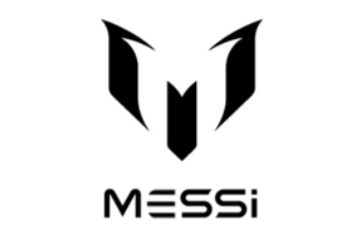



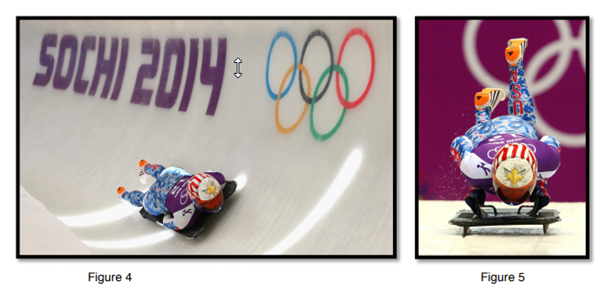
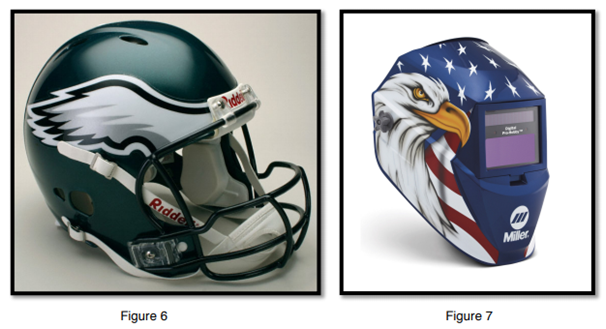
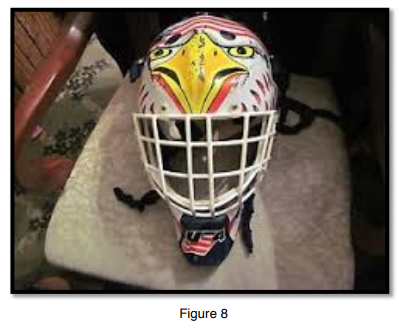
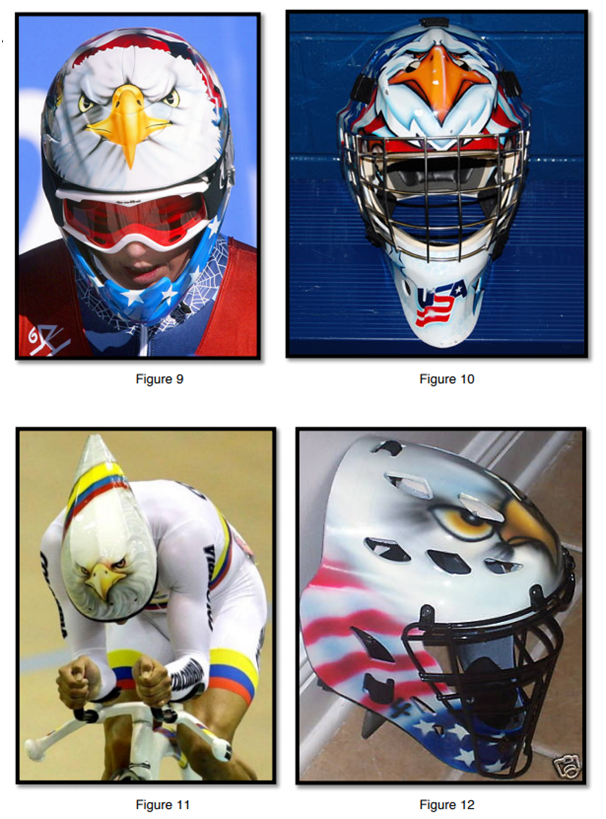
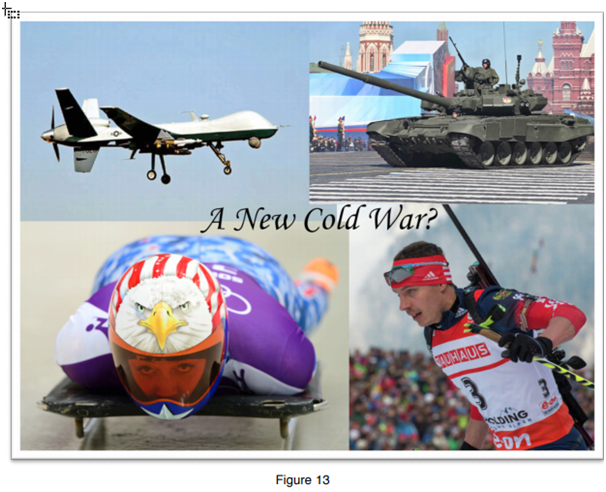

 Không biết phải nói rằng học tiếng Phớp khó hay là dễ nữa. Trước đây nhìn vào nó thì quả thực là như người mù chữ, giờ nhìn vào cũng vẫn như người mù chữ nhưng đoán đoán được một ít.
Không biết phải nói rằng học tiếng Phớp khó hay là dễ nữa. Trước đây nhìn vào nó thì quả thực là như người mù chữ, giờ nhìn vào cũng vẫn như người mù chữ nhưng đoán đoán được một ít.  "
" 